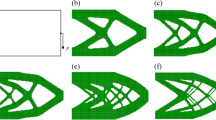Abstract
This paper presents an algorithm for an automatic transformation (= routing) of time-ordered topologies of Goldstone diagrams (i.e., Wick contractions) into graphical representations of these topologies. Since there is no hard criterion for an optimal routing, the proposed algorithm minimizes an empirically chosen cost function over a set of parameters. Some of the latter are naturally of discrete type (e.g., interchange of particle/hole lines due to antisymmetry) while others (e.g., x, y-position of nodes) are naturally continuous. In order to arrive at a manageable optimization problem, the position space is artificially discretized. In terms of the (1) cost function, (2) the discrete vertex placement, (3) the interchange of particle/hole lines the routing problem is now well defined and fully discrete. However, it shows an exponential complexity with the number of vertices suggesting to apply a genetic algorithm for its solution. The presented algorithm is capable of routing non-trivial (several loops and crossings) Goldstone diagrams from given topologies. The resulting diagrams are qualitatively fully equivalent to manually routed ones. The proposed algorithm is successfully applied to several coupled cluster approaches and a perturbative (fixpoint iterative) CCSD expansion with repeated diagram substitution.
















Similar content being viewed by others
References
Coester F (1958) Nucl Phys 7:421
Coester F, Kümmel H (1958) Nucl Phys 9:225
Čížek J (1966) J Chem Phys 45:4256
Paldus J, Čížek J (1975) Adv Quantum Chem 9:105
Paldus J (1977) J Chem Phys 67:303
Goldstone J (1957) Proc R Soc Lond Ser A 239:267
Hugenholtz NM (1957) Physica 23:533
Feynman RP (1949) Phys Rev 76(6):769
Paldus J, Wong HC (1973) Comput Phys Commun 6:1
Csepes Z, Pipek J (1988) J Comput Phys 77:1
Lyons J, Moncrieff D, Wilson S (1994) Comput Phys Commun 84:91
Derevianko A, Emmons ED (2002) Phys Rev A 66:012503
Mathar RJ (2007) Int J Quantum Chem 107:1975
Wick GC (1950) Phys Rev 80:268
Kállay M, Surján PR (2001) J Chem Phys 115:2945
Harris FE (1999) Int J Quantum Chem 75:593
Dzuba VA (2009) Comput Phys Commun 180:392
Hanrath M (2007) Equivalence class decomposition of contraction patterns in Wick’s theorem exploiting tensor anti-symmetry: application to three-body terms (unpublished results)
Hanrath M (2008) A general and efficient diagrammatic term simplification engine: evaluation of the wave function variance (unpublished results)
Hanrath M (2019) Diag2PS—a text driven diagram assembling tool based on PSTricks. www.tc.uni-koeln.de/people/hanrath/Interactive/Diag2PS. Accessed 11 Sept 2019
Shavitt I, Bartlett RJ (2009) Many-body methods in chemistry and physics—MBPT and coupled-cluster theory. Cambridge University Press, Cambridge
Harris FE, Monkhorst HJ, Freeman DL (1992) Algebraic and diagrammatic methods in many-Fermion theory. Oxford University Press Inc, Oxford
Crawford TD, Schaefer HF III (2000) Rev Comput Chem 14:33
Baker H (1902) Proc Lond Math Soc 34(1):347
Campbell J (1897) Proc Lond Math Soc 28:381
Hausdorff F (1906) Berl Verh Sächs Akad Wiss Leipz 58:19
Holland JH (1975) Adaption in natural and artificial systems. University of Michigan Press, Ann Arbor
Kumar M, Husian M, Upreti N, Gupta D (2010) Int J Inf Technol Knowl Manag 2(2):451
Engels-Putzka A, Hanrath M (2011) J Chem Phys 134:124106
Hanrath M, Engels-Putzka A (2010) J Chem Phys 133:064108
Author information
Authors and Affiliations
Corresponding author
Additional information
Publisher's Note
Springer Nature remains neutral with regard to jurisdictional claims in published maps and institutional affiliations.
Electronic supplementary material
Below is the link to the electronic supplementary material.
Rights and permissions
About this article
Cite this article
Herrmann, N., Hanrath, M. Automatic routing of Goldstone diagrams using genetic algorithms. Theor Chem Acc 138, 117 (2019). https://doi.org/10.1007/s00214-019-2505-3
Received:
Accepted:
Published:
DOI: https://doi.org/10.1007/s00214-019-2505-3




